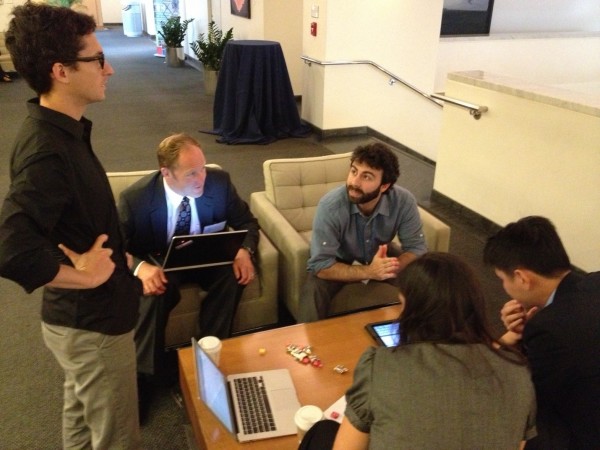12 June 2013
Tiny vocabulary spurs scientists’ verbal creativity
Posted by Michael McFadden
By Mary Catherine Adams and Peter Weiss
Here’s a challenge for scientists who want an eye-opening experience in communicating using simple language: Give up 90-plus percent of the thousands of words you rely on in everyday life, but try nonetheless to convey the key concepts and ideas of your science.
That’s what about 30 scientists did last week at a science communication workshop offered by the American Geophysical Union. The workshop was part of the American Meteorological Society’s Summer Policy Colloquium.

Scientists at last week’s workshop discuss how to explain Kepler’s laws using nothing but the 1,000 most common English words. Photo by Mary Catherine Adams
Working in four small groups, the attendees used an online editing program called The Up-Goer Five Text Editor to create short, plain-language blurbs about a science topic. The Text Editor rejects words that aren’t among the 1,000 most common ones in the English language.
The idea wasn’t to create perfect prose but to practice the verbal creativity needed to communicate with a more widely understood vocabulary than scientists are accustomed to using. In the process, the groups explained some complex science topics in very plain (sometimes comically so) language.
Here’s what the groups came up with:
The Greenhouse Effect
The world would be too cold for life if there was no air. The air is made of many kinds tiny pieces. Some kinds of the tiny pieces make the world warm. Too many pieces can make the world too warm. This is how it works.
The world stays warm because the sun sends warm light to the ground and makes the ground warm. Because the ground is warm, it sends some of the warm stuff into the sky air. The kinds of tiny pieces that make the world warm, hold the warm stuff in the sky air. Part of the warm stuff is sent into space and part to the ground, and this makes the ground warmer. When the cars and cities burn stuff to go places, stay warm, and turn on the lights, we make more of the tiny pieces that go into the sky air and holds the warm stuff. This will make the world too hot.
By: Bonnie Brown, Percy Link, Esther Mullens, Danielle Nagele, Alexandra Noronha, and Carly Robinson
Remote sensing
Using light or sound, you can learn about something without touching it. It helps us learn about things from far away that might be hard to reach. Eyes and ears work this way but not touch. We can learn how hot something is, if it will rain, or about the wind. One way people use it all the time is cell phone pictures. People who think they have big brains use it for work.
By: Aparna Bamzai, Margaret Garcia, Katelynn Greer, Stephen Iwuozo, Scott Mackaro, Kim Manago, and Galen Treuer
Kepler’s Laws (of planetary motion)
Some Old White Guy’s Ways Of Saying That Big Round Space Things Move
1. The way each big round space thing moves around the sun is like walking around a race track with the sun at one of the two end points on the inside of that race track.
2. When the big round space thing moves around the sun, the time the big round space thing takes to cover an area is always the same IF the areas are also the same.
3. The time that it takes for the big round space thing to move around the sun is a lot like half the way between the big round space thing and the middle of the race track (with some hard number stuff added in there, too).
Knowing this makes your phone work. Not giving money to people that do this stuff might make TV go away.
By: Evan Couzo, Christie Lee, KJ Liao, Jay Searles, and Nicholas Weber
And, finally, another complex, but more widely familiar, subject:
Rainbows
We will talk about the half ring of pretty colors in the sky that happens after it rains. The light from the sun has all the colors we can see with our eyes and when they move together in the same direction they look white. After it rains some small water drops stay in the air. When the light hits the water drops in the air each color moves in its own way. Each color shifts and leaves the water drops in a slightly different direction from the others. Now the colors are no longer together so we can see each single color on its own. This gives us the half ring of color in the sky which small men dressed in green follow to their large cup of pretty rock money!
By: Christa Hasenkopf, Emily Jannsen, Teresa Mathews, Geeta Persad, Amanda M. Sheffield and Anastasia Yanchilina
Making complex science topics understandable to general audiences requires preparation and practice. Though this exercise takes it to the extreme, thinking about the importance of each word like these scientists did can really help to make messages effective and successful. The workshop also included a panel of professional science communicators, a talk on building relationships with policy makers, a session on creating brief, clear communications about science, a skit, and mock interviews and communications scenarios.
– Mary Catherine Adams, AGU Public Information Specialist and Peter Weiss, AGU Public Information Manager










 The Plainspoken Scientist is the science communication blog of AGU’s Sharing Science program. With this blog, we wish to showcase creative and effective science communication via multiple mediums and modes.
The Plainspoken Scientist is the science communication blog of AGU’s Sharing Science program. With this blog, we wish to showcase creative and effective science communication via multiple mediums and modes.